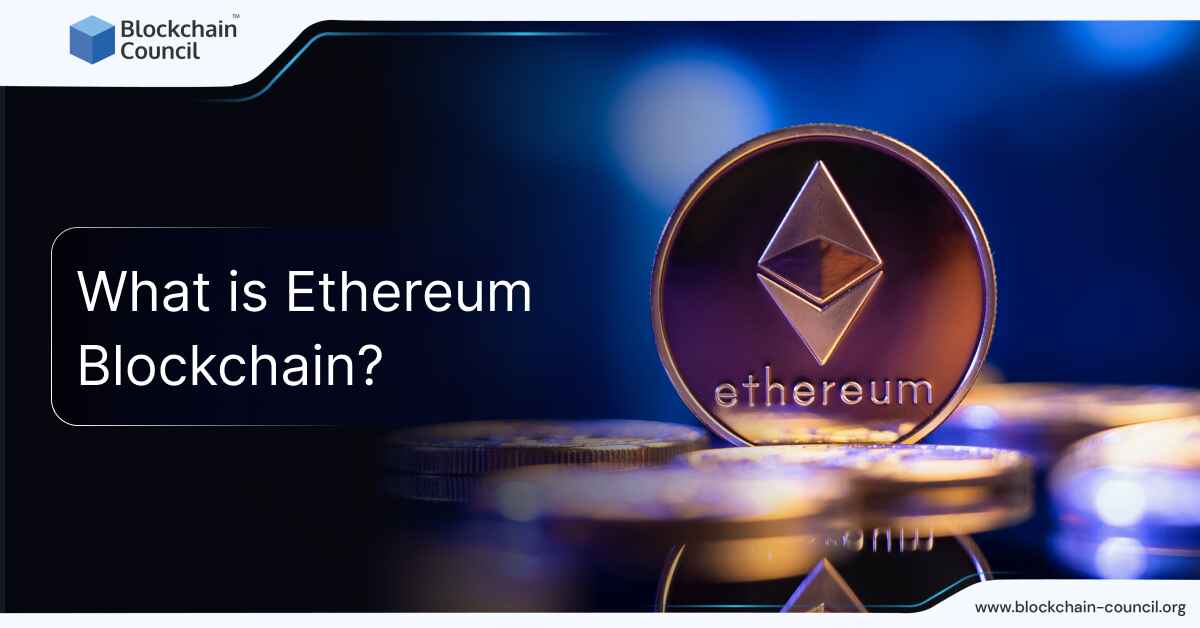
- Blockchain Council
- September 02, 2024
Introduction
In the landscape of blockchain technology, Ethereum stands out as a pioneering platform that extends the capabilities of blockchain beyond simple transactions. Since its launch in 2015 by Vitalik Buterin and a team of developers, Ethereum has revolutionized the decentralized application (dApp) ecosystem, offering developers a platform to build a wide array of applications ranging from decentralized finance (DeFi) to non-fungible tokens (NFTs). In this comprehensive guide, we delve into the fundamentals of the Ethereum blockchain, its underlying technology, key features, applications, and future prospects.
Understanding Ethereum Blockchain
At its core, Ethereum blockchain is a decentralized, open-source platform that enables the creation and execution of smart contracts and decentralized applications (dApps). Unlike Bitcoin, which primarily serves as a digital currency and payment system, Ethereum’s blockchain is designed to be a programmable platform, allowing developers to build and deploy smart contracts and dApps.
Key Components of Ethereum Blockchain
- Ether (ETH): Ether is the native cryptocurrency of the Ethereum blockchain, serving as the fuel for executing transactions and smart contracts on the network. Ether is also used as a store of value and a medium of exchange within the Ethereum ecosystem.
- Smart Contracts: Smart contracts are self-executing contracts with the terms of the agreement directly written into code. On the Ethereum blockchain, smart contracts are deployed and executed on the Ethereum Virtual Machine (EVM), a decentralized runtime environment. Smart contracts enable automated and trustless execution of agreements, eliminating the need for intermediaries.
- Ethereum Virtual Machine (EVM): The Ethereum Virtual Machine (EVM) is a decentralized runtime environment that executes smart contracts on the Ethereum blockchain. The EVM enables developers to write smart contract code in high-level programming languages such as Solidity, which is then compiled into bytecode and deployed on the blockchain..
- Gas: Gas is the unit used to measure the computational work required to execute transactions and smart contracts on the Ethereum blockchain. Users must pay a certain amount of gas to miners as a transaction fee to prioritize their transactions on the network. Gas fees are denominated in ether and vary depending on the complexity and computational resources required for the transaction or smart contract execution.
Applications of Ethereum Blockchain
- Decentralized Finance (DeFi): Ethereum has emerged as the leading platform for decentralized finance (DeFi) applications, offering a wide range of financial services and products without the need for traditional intermediaries. These include decentralized exchanges (DEXs), lending and borrowing protocols, liquidity pools, derivatives, and yield farming platforms.
- Non-Fungible Tokens (NFTs): Ethereum has become the go-to platform for the creation and trading of non-fungible tokens (NFTs), which represent unique digital assets such as digital art, collectibles, virtual real estate, and in-game items. NFTs leverage Ethereum’s smart contract functionality to ensure authenticity, ownership, and scarcity of digital assets.
- Decentralized Autonomous Organizations (DAOs): Ethereum enables the creation and operation of decentralized autonomous organizations (DAOs), which are organizations governed by smart contracts and operated by their members without central control. DAOs utilize Ethereum’s smart contract functionality to automate decision-making, voting, fund management, and governance processes.
Challenges and Limitations
Despite its groundbreaking innovations, Ethereum faces several challenges and limitations:
- Scalability: Ethereum’s current architecture faces scalability issues, particularly during periods of high network congestion. The limited throughput of the Ethereum blockchain results in slow transaction times and high gas fees, hindering its ability to support mass adoption and mainstream usage.
- Security: While Ethereum’s smart contracts offer unprecedented functionality, they are also susceptible to security vulnerabilities and exploits. Smart contract bugs and coding errors have led to significant financial losses in the past, highlighting the importance of thorough auditing and testing processes.
- Environmental Impact: Like Bitcoin, Ethereum relies on a proof-of-work consensus mechanism, which consumes a significant amount of energy. The environmental impact of Ethereum’s energy-intensive mining process has raised concerns about its sustainability and carbon footprint.
Future Outlook
Despite these challenges, the future outlook for Ethereum remains optimistic. The Ethereum community is actively working on solutions to address scalability, security, and sustainability concerns. Ethereum 2.0, a major upgrade to the Ethereum blockchain, aims to transition from proof-of-work to proof-of-stake consensus mechanism, thereby improving scalability and reducing energy consumption.
Conclusion
In conclusion, Ethereum blockchain represents a significant advancement in the realm of blockchain technology, offering developers and users a platform for building and deploying decentralized applications and smart contracts. From decentralized finance to non-fungible tokens and decentralized autonomous organizations, Ethereum has unlocked a world of possibilities for innovation and experimentation. While challenges remain, Ethereum continues to evolve and innovate, paving the way for a more decentralized, transparent, and inclusive future. As we embark on this journey of exploration and discovery, Ethereum remains at the forefront of the blockchain revolution, empowering individuals and communities to build a more equitable and decentralized world.





































































 Guides
Guides News
News Blockchain
Blockchain Cryptocurrency
& Digital Assets
Cryptocurrency
& Digital Assets Web3
Web3 Metaverse & NFTs
Metaverse & NFTs
